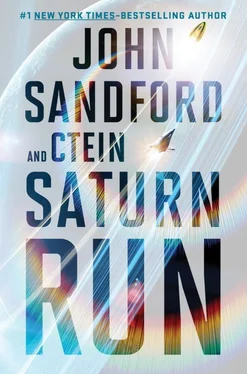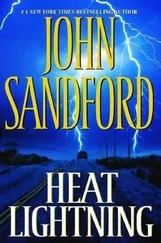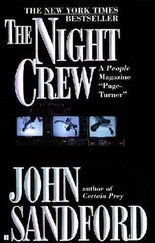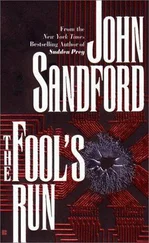Hannegan said, “But if it feeds us incorrect information on physics, we’ll find that out pretty quickly. I personally don’t care if it’s lying about what the various species are like, if it could deliver, say, a thirtieth-century Physics Handbook .”
Stuyvesant: “That’s a little parochial, Bob.”
Hannegan: “Yeah, well, what if he could deliver a thirtieth-century Biochemistry Handbook ?”
“That would be helpful,” Stuyvesant admitted.
Barnes said, “Our jukebox raised another concern. New question: Why do we have to worry about harming ourselves or the depot?”
The jukebox said, “This depot has technologies and artifacts from many different species. No visitor could be familiar with them all. Some of these devices are dangerous if misused, the same way a milling laser is dangerous if misused.”
Clover nodded: strange technology, strange tools.
The jukebox: “Also, there are containment modules that should not be accessed without proper instruction, as they currently hold a total of eight hundred and forty-nine tonnes of antimatter.”
“Holy shit,” Hannegan said. “Uh, where did all this antimatter come from?”
“It’s manufactured here.”
Before anyone could say anything, Barnes barked, “All right, everybody, speakers off, intersuit comm channel 7, full encryption, wait for my lead.”
When everybody had gone to encryption, he said, “This is exactly why our mission was top priority for the U.S. We need to secure this, or make sure that nobody else gets their hands on it. That is a buttload lot of antimatter. Bob, thoughts?”
The physicist had been looking off in a distracted way and tapping the fingers of one hand together. “Yeah, I’m doing a little mental arithmetic here. If the Wurlitzer is telling the truth, that’s on the order of a teratonne explosive equivalent. Call it a million of those H-bombs the superpowers used to stockpile. Which immediately has me wondering, first, where is it? And second, how are they making it? Related to that, where are they getting the power to make it?”
Barnes said, “Numbers one and two are what most concern me. Plus, there’s a number four: Will the answer-bot tell us how to make it?”
“Let’s go back to the jukebox.” They turned back to the answer-bot. “Excuse us, we need to discuss the information you imparted.”
“My programming informs me that is very common with first arrivals and I am not programmed to take offense in any way. Do you have any other questions at this time?”
Hannegan cleared his throat: “Uh, you said this depot stored over eight hundred tonnes of antimatter. Where? And how?”
The jukebox said, “The constellation of small moonlets you see associated with this depot are the containment modules for the antimatter. The material is in the form of iron-58, which is electromagnetically isolated from the walls of the modules.”
Hannegan raised his eyebrows: “Anti-iron? We can barely manage anti-helium. How do you make this and where do you get the power? For us, manufacturing that quantity of antimatter would require roughly a year’s worth of solar output.”
There was a perceptible pause as the answer-bot considered its answer. Then:
“I can’t give you an accurate answer to your first question unless your engineers can establish a high-bandwidth I/O path. Very inaccurately and roughly, the transformation reaction makes use of a supersymmetric resonance to convert protons to antiprotons. An analogous lepton pathway produces positrons. Assembling those into neutrons and higher-order nuclei is a straightforward exploitation of a subset of localized D brane excitations to chain up isotopic ladders of least resistance—”
Hannegan said, “Okay, stop. I get it. We’ll wait for the interface.”
“As for your second question, this depot taps the rotational energy of Saturn for power. The reaction pathway is approximately twenty percent efficient. Consequently this depot can produce something in excess of one billion tonnes of antimatter before Saturn’s rotational period will be significantly altered.”
Hannegan glanced at Barnes, then asked, “Can you provide engineering designs and instructional manuals for the antimatter production and containment facilities?”
This time there was no hesitation in the response. “That information is exportable to all species.”
Barnes said, “I think that’s enough for this session. We should return to our ship now. Are we allowed to return at any time?”
“Yes, at any time.”
“We will bring engineers to discuss a high-bandwidth I/O pathway. May they come at any time?”
“Yes, at any time.”
Sandy cut in. “Speaking of which, can you establish a link so that I’ll be able to transmit directly to our ship from here?”
“EM-blocking is an initial precaution. The security system will establish a communications link for you before your next visit.”
Fiorella, who’d kept her mouth shut, jumped in: “George, please: give me one minute. Or two minutes. No more than two minutes. Three at the outside.”
Barnes grinned and said, “Two minutes, Cassie.”
Fiorella moved up to the jukebox with Sandy switching between cameras to provide a range of views. She asked the machine, “Do you have a name?”
“I have understood that you call me jukebox.”
“That’s because you look like an antique music machine from Earth, called a Wurlitzer. Could we name you Wurly?”
“Yes.”
Barnes groaned, Clover laughed, and Fiorella asked, “Wurly, do you have any historical records? Of events in other systems?”
“Yes. My records contain a generalized history of this galactic arm.”
“If you have no information about other species, how can you have a history?”
“Because the history has no specific information about other species. The species are designated by number and date of emergence and tradable items. Specific information on the species is not available through my memory banks.”
“That information must exist somewhere.”
“Yes, that is logical.”
“Do you have tradable items stored here?”
“Yes.”
“Do we have access to them?”
“Under the terms of tradable items, yes. However, you must have items to trade.”
Now Clover got back in: “How can we provide items to trade if our technology is so much lower than star-traveling species?”
“Most tradable items are not technological. One questioner referred to an antique music machine. Music machines are often tradable. There is a trade AI that will determine if your music machines are tradable, and if so, what level of trade you may access. In general, these are not valued highly, as it is very likely that other civilizations already have music machines resembling yours, and manufacturing specifications can be simply transmitted, which is vastly less costly than carrying physical goods between stellar systems. But the actual alien machines may be valued by collectors in some cultures, as visual artworks are in yours. Some musical compositions might also be tradable, for similar reasons.”
Sandy: “We gotta have a hundred and fifty instruments on board—I’ve got eight guitars down in the fab shop area, and we’ve gotta have a million songs on file, from Bach to Kid Little.”
Barnes said, “Yeah, yeah, we’ll discuss that later.”
Clover raised a finger. “Uh… Wurly… are there any classes of trade goods that we ‘primitives’ might have that would garner us more trade credit?”
“You are not considered ‘primitives,’ merely less technologically advanced.”
Clover muttered into a private comm channel, “It doesn’t get sarcasm. Probably not a high-level AI, as it says… or it’s a great faker.”
Читать дальше








